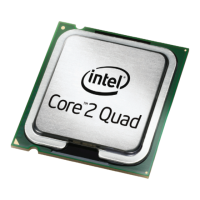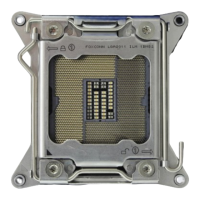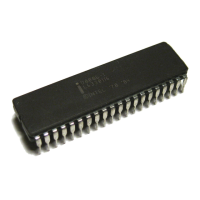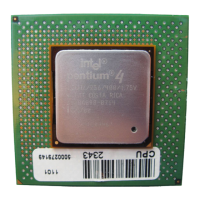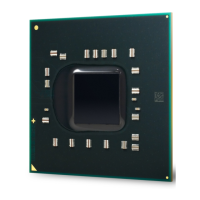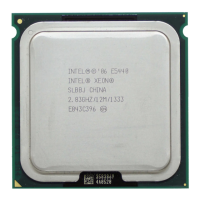Introduction
14 Quad-Core Intel® Xeon® Processor 5300 Series Datasheet
• LGA771 socket – The Quad-Core Intel® Xeon® Processor 5300 Series interfaces
to the baseboard through this surface mount, 771 Land socket. See the LGA771
Socket Design Guidelines for details regarding this socket.
• Processor core – Processor core with integrated L1 cache. L2 cache and system
bus interface are shared between the two cores on the die. All AC timing and signal
integrity specifications are at the pads of the processor die.
• FSB (Front Side Bus) – The electrical interface that connects the processor to the
chipset. Also referred to as the processor system bus or the system bus. All
memory and I/O transactions as well as interrupt messages pass between the
processor and chipset over the FSB.
• Dual Independent Bus (DIB) – A front side bus architecture with one processor
on each bus, rather than a FSB shared between two processor agents. The DIB
architecture provides improved performance by allowing increased FSB speeds and
bandwidth.
• Flexible Motherboard Guidelines (FMB) – Are estimates of the maximum
values the Quad-Core Intel® Xeon® Processor 5300 Series will have over certain
time periods. The values are only estimates and actual specifications for future
processors may differ.
• Functional Operation – Refers to the normal operating conditions in which all
processor specifications, including DC, AC, FSB, signal quality, mechanical and
thermal are satisfied.
• Storage Conditions – Refers to a non-operational state. The processor may be
installed in a platform, in a tray, or loose. Processors may be sealed in packaging or
exposed to free air. Under these conditions, processor lands should not be
connected to any supply voltages, have any I/Os biased or receive any clocks.
Upon exposure to “free air” (that is, unsealed packaging or a device removed from
packaging material) the processor must be handled in accordance with moisture
sensitivity labeling (MSL) as indicated on the packaging material.
• Priority Agent – The priority agent is the host bridge to the processor and is
typically known as the chipset.
• Symmetric Agent – A symmetric agent is a processor which shares the same I/O
subsystem and memory array, and runs the same operating system as another
processor in a system. Systems using symmetric agents are known as Symmetric
Multiprocessing (SMP) systems.
• Integrated Heat Spreader (IHS) – A component of the processor package used
to enhance the thermal performance of the package. Component thermal solutions
interface with the processor at the IHS surface.
• Thermal Design Power – Processor thermal solutions should be designed to meet
this target. It is the highest expected sustainable power while running known
power intensive real applications. TDP is not the maximum power that the
processor can dissipate.
• Intel® 64 Architecture – Instruction set architecture and programming
environment of Intel’s 64-bit processors, which are a superset of and compatible
with IA-32. This 64-bit instruction set architecture was formerly known as IA-32
with EM64T or Intel® EM64T.
• Enhanced Intel SpeedStep® Technology – Technology that provides power
management capabilities to servers and workstations.
• Platform Environment Control Interface (PECI) – A proprietary one-wire bus
interface that provides a communication channel between Intel processor and
chipset components to external thermal monitoring devices, for use in fan speed
control. PECI communicates readings from the processor’s Digital Thermal Sensor
(DTS). The replaces the thermal diode available in previous processors.

